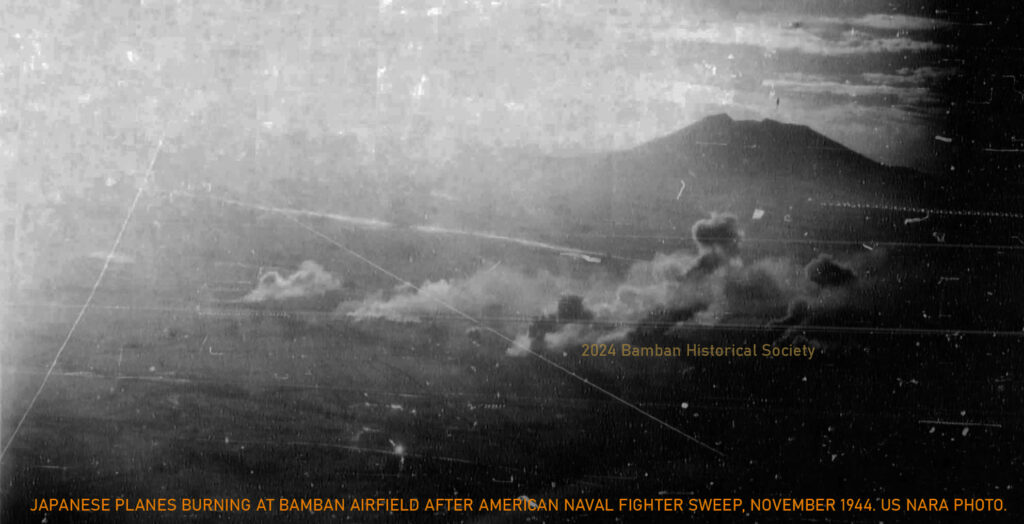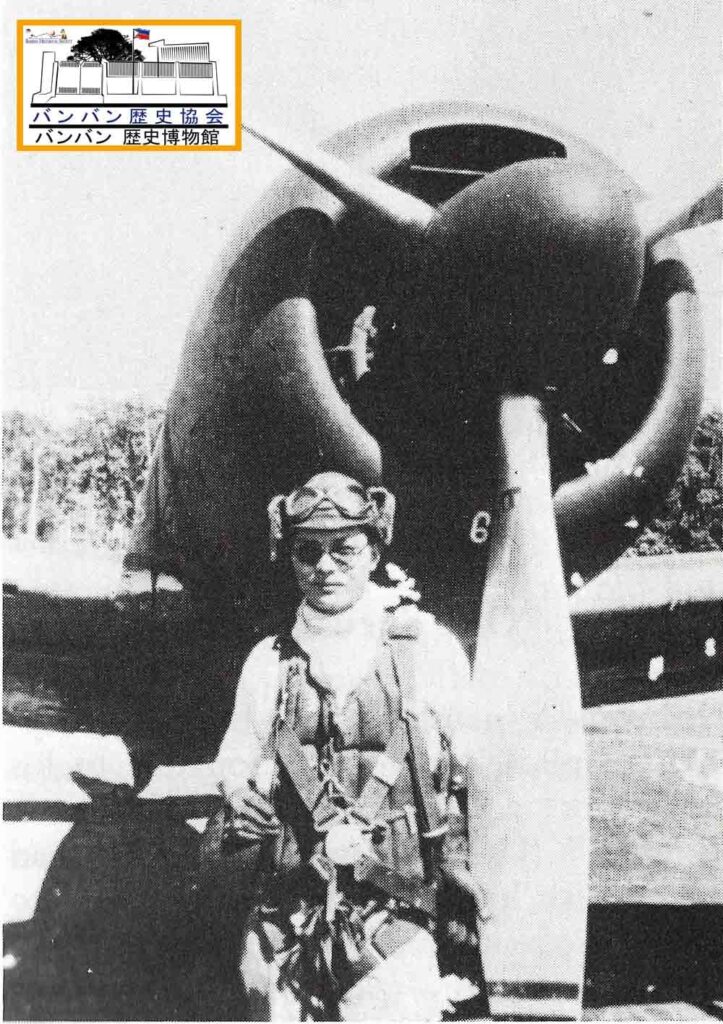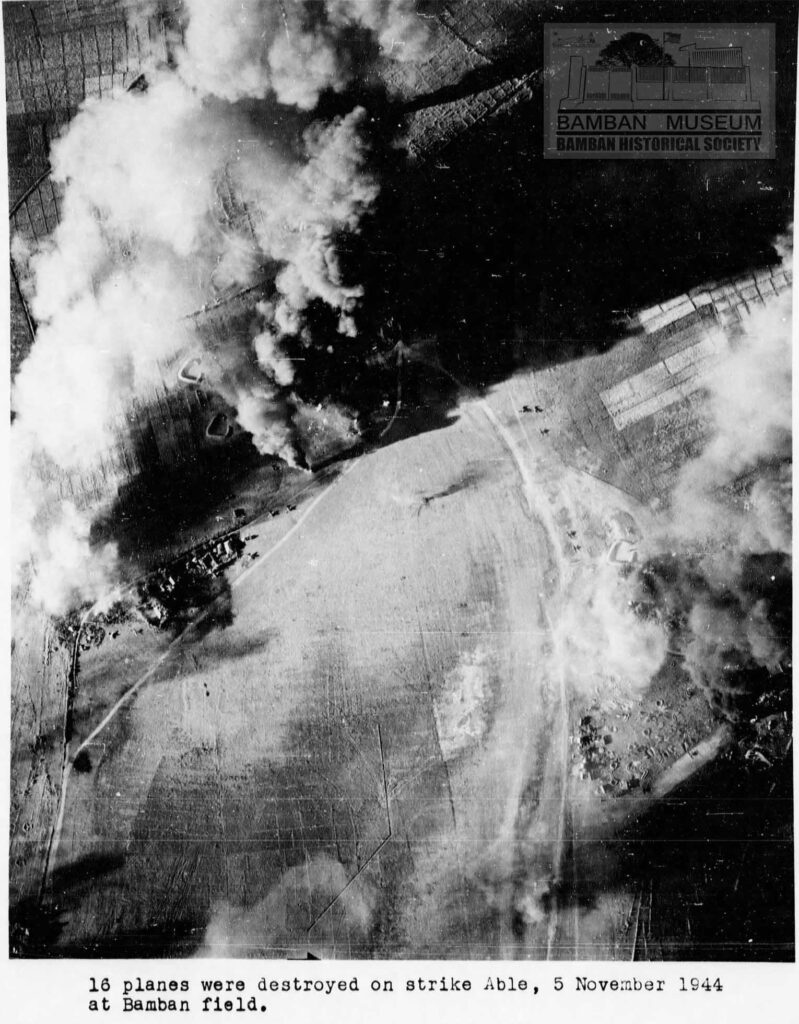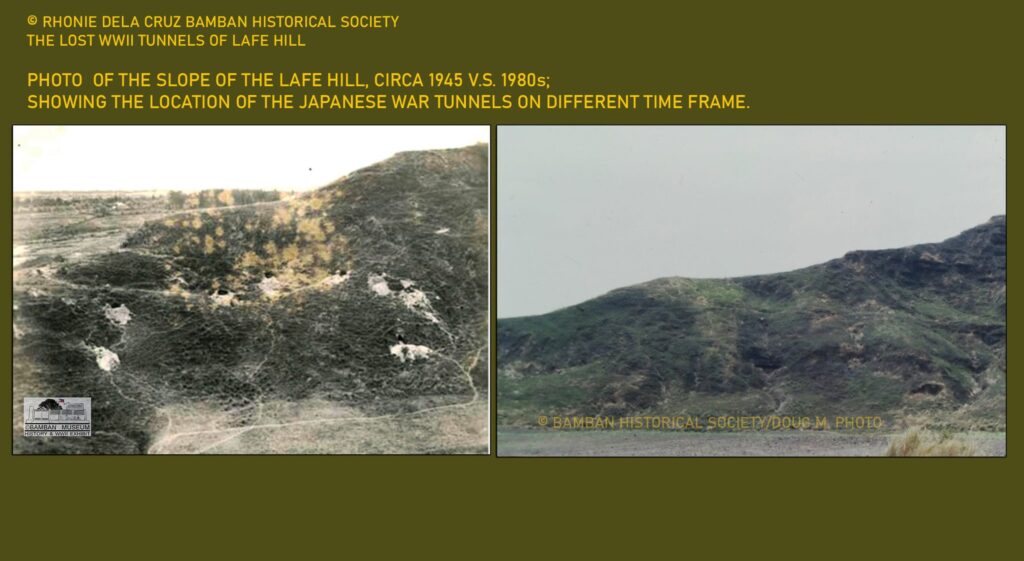
CLARK FIELD 1944 – クラーク飛行場1944年。
Clark Airfield and its satellite air strips in Bamban (Tarlac province), Mabalacat, Angeles and Porac (Pampanga province) covering about 13 fields became one of the biggest and most important air facilities in the Philippines in 1944. On September 21, 1944, carrier-borne fighters and bombers of the US Navy conducted its first air combat operations against Japanese facilities in Luzon and in Clark airfields including the Bamban. Thereafter, in almost daily rate, successive air combat sorties were carried out by the US Navy in support of the Leyte Operations on the airstrips of Clark.

US National Archives courtesy of Dave Metherell.
MOBILIZATION OF JAPANESE NAVY & ARMY AIR FORCES – 日本の陸海軍空軍の配備計画。
Mobilizations of the air units by the Imperial Japanese Navy were carried out as the Japanese Leyte Operations or Sho Ichi Go was executed with the arrival of the American forces at the mouth of Leyte Gulf. These navy units composed the Second Air Fleet led by Vice-Admiral Fukutome coming from the airfields of Taiwan and Japan. Soon, the Imperial Japanese Army followed suit with the mobilization of the 30th Fighter Group and other units to be attached with the 4th Air Army. Many of these fighters from the units were assigned at Clark Air Center.
THE OCTOBER 29, 1944 AIR OPERATIONS – 空軍作戦、1944 年 10 月 29 日。
In October 29, 1944, a massive aerial fighter sweeps were conducted by the F6F-5 Grumman fighters, TBM-3 torpedo-bombers and SB2C bombers from carriers of the Task Force 38, US Third Fleet under Vice-Admiral William Halsey into the Japanese hornet’s nest; the Clark Air Center. Soon, fighter interceptors mostly A6M Zero and Zekes from the airfields of the Bamban, Clark, Mabalacat, Angeles, Floridablanca and Porac rose to meet the American raiders and dogfights ensued over the airfields, which became the major air intercept battle fought in the Philippines during WWII with 142 aircraft participating in the air war.

THE NOVEMBER 5-6, 1944 AIR INTERCEPT BATTLES OVER CLARK FIELDS – 1944年11月5日と6日、クラーク飛行場上空での空戦。
Post operation analysis conducting by the US Third Fleet indicated the presence of many Japanese aircraft sortied from Clark area in spite of the massive bombing sweeps on October 29. Hence, another major bombing operation had been planned to destroy Japanese assets at Clark. On the morning of November 5, 1944, fighters, dive-bombers, and torpedo bombers from USS Wasp took off for fighter sweeps over Bamban airfield to destroy Japanese air strength and assets. This mission was in conjunction with the us navy task group 38.1 (includes carrier Wasp, Hornet, Monterey, And Cowpens) objective of launching mission against the heavy Japanese air concentration on Luzon on the said date which was located mostly at the Clark air center with air strips at Bamban, Mabalacat, Clark proper, and Angeles. In the aftermath of this air intercept battles, many American and Japanese naval aviators including ace pilots were shot down during the dogfights. It was one of the biggest air intercept battles in the Philippines as recorded by Japanese military.

Source: Tillman, Barret. Hellcat Aces of WWII.
DOGFIGHTS – アメリカ空軍と日本空軍の間の空戦。
Three successive air strikes were conducted by the units from USS Wasp (Fighter Squadron VF-14, Bomber Squadron VB-14, and Torpedo Bomber Squadron VT-14) over the Bamban. Bamban airfield was predominantly operated by Japanese air force with “Oscars”, “France”, “Helen”, and “Tony’s types of plane but with the Leyte operation, various navy units were assigned at the airfield ready for air interception mission with “Zeke” and “George” aircraft, particularly Air Group 203 and Air Group 653. The airfield was defended by anti-aircraft batteries from light, medium to heavy gun categories with the 75mm AA and the Japanese navy 120mm dual-purpose guns.
As the Curtiss SB2C navy bombers and TBM3 torpedo-bombers from Squadron VB-14 and VT-14 were to drop their payloads over targets at the airfield, Japanese navy carrier fighter A6M5 Zekes’ took-off from Bamban air strips and engaged the attackers. Fighters from VF-14 with F6F-5 “Grumman” were quick to engage the incoming Zekes on the north eastern corner of the field for the air intercept battle or “dogfight”, in making their final strike against targets at the airfield, the dive-bombers and torpedo bombers were forced to dive directly through this dogfight.
THE JAPANESE RESISTANCE – 日本の抵抗。
The air combat missions or “fighter/bombing sweeps” were met with strong oppositions over the skies of Clark Air Center, with the cream of Japanese pilots including ace pilots from the 6th Base Air Force of Admiral Fukudome, along with the 5th Base Air Force of Admiral Ohnishi. Aside from the air intercept, the Japanese air sector command of the Clark Airfield, along with its army counterparts, had established a very potent anti-aircraft defenses that would prove fatal to some American raiders. Leading Japanese naval pilots, mostly from Admiral Fukudome’s 6th Base Air Force from the Fighter Hikotai 316 from Mabalacat Airfield and 203 Kokutai (air group) from the Bamban were killed during the air intercept battle on the November 5-6; with Chief Petty Officer Ki-Ichi Nagano, a naval ace pilot (with 19 kills to his credit) shot down over the Bamban airfield.

At the day’s end, the air strike missions at Bamban along with the Clark Air Center resulted in the loss of 72 Japanese aircraft destroyed and damaged on the ground and 33 aircraft destroyed in the air interception. However, the Japanese air strength remains strong in spite of this major air strike and fighter sweeps. Japanese air assets including anti-aircraft defenses over the airfields were to continue growing and American naval forces from Task Group 38 will continue to conduct various missions against Japanese installations at the Bamban and the other strips of Clark Air Center.

GUERRILLA RESCUE OPERATION ON DOWNED AMERICAN PILOTS – アメリカ人パイロットがフィリピンゲリラに助けられた。
Some of the US navy bombers (SB2C-3 and SBW-3) from USS Wasp were shot down, with Ensign R.O. Burnham, ARM2c H.A. Diner, and Lieutenant JG Wisnyi. While the bombing sweeps was on-going on the fateful day, the local USAFFE guerrillas in the vicinity of Clark Air Center, including the Squadron 155 under the command of Captain Henry Conner (27th Bomb Group) and Bruce Guerrillas led by Captain Alfred Bruce (12 MP, Philippine Scouts) of the South Tarlac Military District. Ensign Burnham and ARM2c Diner were both rescued by the local USAFFE guerrillas from O’Donnell Regiment (Capas) under the control of Captain Bruce.
The fighter and bombing sweeps on November 5, 1944 carried out by the US Navy’s Task Force 38 over Clark Air Center continued on the next day, pounding Japanese targets such as buildings, troops barracks, revetments, dispersal areas, parked aircrafts and anti-aircraft batteries. Similarly, Japanese fighters mostly A6M Zekes conducted air intercepts on the American naval fighters, bombers and torpedo-bombers, mostly from the 6th Base Air Force assigned at the area including those from the Bamban Airfield. Along with the major air combat missions on the October 29 by the Task Force 38 of the US Navy in support of the Leyte Operations, these were the fiercest air intercept battles recorded by the Japanese military in relation to their Sho Ichi Go (Leyte) Operations; involving both the Japanese and American air services with the local USAFFE guerrillas from northwest Pampanga and south Tarlac who were tasked to rescue any downed American pilots while the Japanese patrols on the ground were in hot pursuit of any American pilots who may parachute in their territory.

Source: US National Archives NARA courtesy of Dave Metherell.
Many American and Japanese pilots gave the ultimate sacrifice on these air intercept battles. Local Filipino guerrillas and civilians also paid the ultimate price in protecting and safeguarding American downed pilots. It is just fitting that this part of History of WWII shall be remembered, albeit now considered to be a forgotten account of events in our nation’s history.
Rhonie Dela Cruz – ローニーC.デラクルス
Bamban Historical Society
Bamban Museum of History
SOURCES:
(A) Japanese Naval Aces and Fighter Units in WWII.
(B) Aircraft Action Report No. 22 November 5, 1944 Strike on Luzon USS Wasp. Manuscript. National Archives NARA, Courtesy of David Metherell.
© Aircraft Action Report No. 122 November 5, 1944 Strike on Luzon USS Wasp. Manuscript. National Archives NARA (Courtesy of David Metherell)
Morrison, Samuel Eliot. History of the United States Naval Operations in WWII Volume XII – Leyte: June 1944 – January 1945.
PHOTOS
(1) The USS Wasp’s air raid over Bamban Airfield, November 5, 1944.
Source: US National Archives courtesy of Dave Metherell.
(2) F6F-5 Grumman aboard an aircraft carrier from the US Navy Task Force 38 for a morning strike and fighter sweeps over Clark Field, November 5, 1944.
Source: Tillman, Barret. Hellcat Aces of WWII.
(3) Aftermath of the bombing sweeps of US Navy bomber Curtiss SB2-C on targets such as aircraft dispersal areas at Mabalacat East Airfield, November 5, 1944.
(4) Chief Petty Officer Ki-Ichi Nagano, a Japanese leading naval ace from Air Group 203 based at Bamban Airfield, died during the air intercept battle on November 5, 1944.
(5) A US Navy aircraft (possibly Grumman F6F Hellcat), marked in circle, is seen on this image as crashing on the grounds of the Clark Field on November 5, 1944.
Source: US National Archives courtesy of Dave Metherell.
(6) Japanese targets at Bamban Airfield go into smoke, in an aftermath of the fighter and bombing sweeps on November 5, 1944.
Source: US National Archives courtesy of Dave Metherell.


